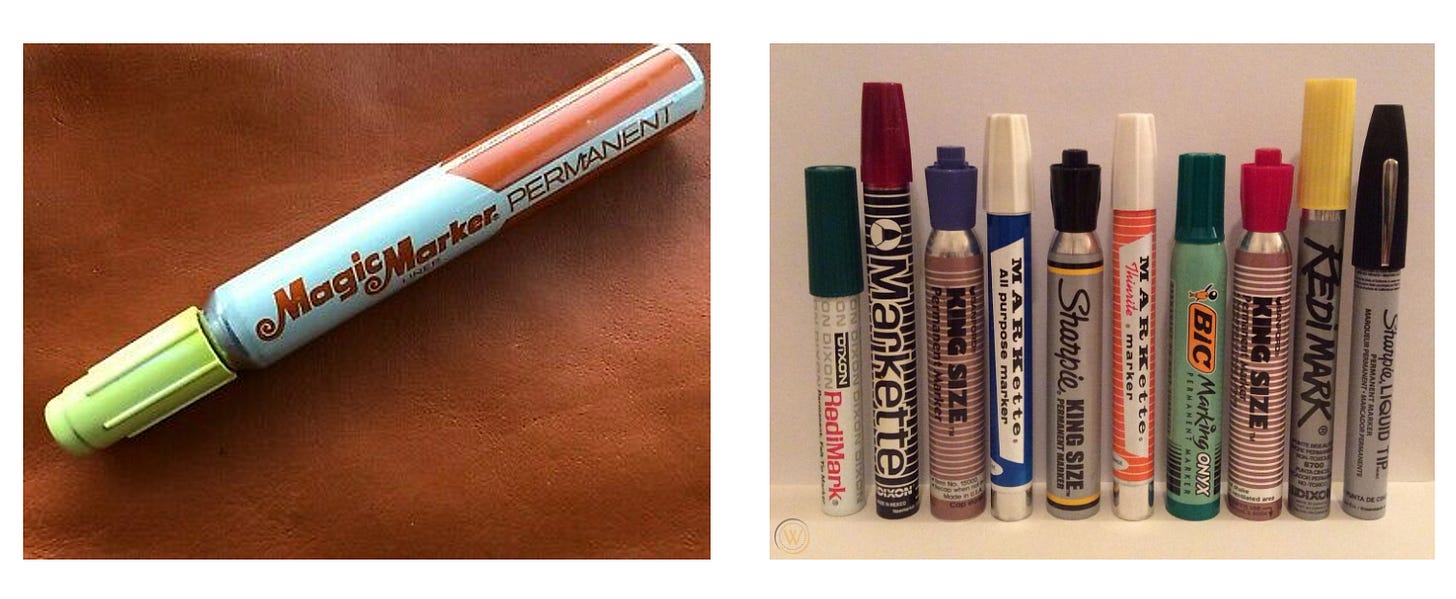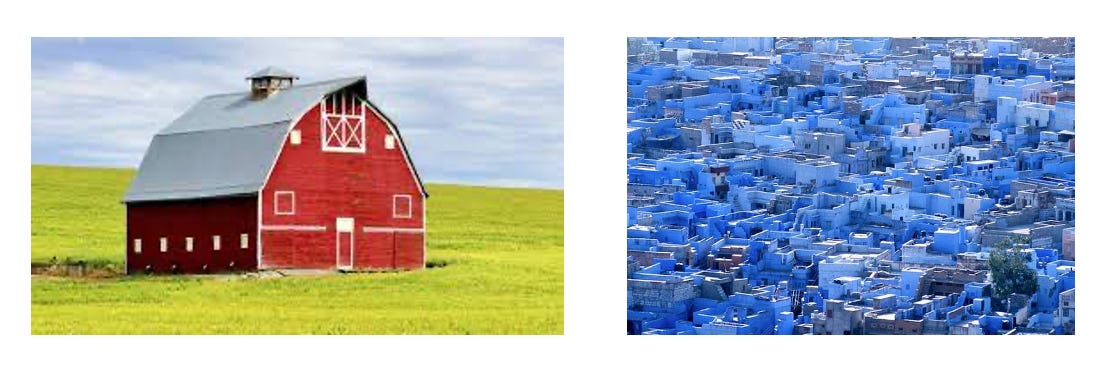Consider: The Sharpie
The tattoo gun of markers.
Sorry about the delayed delivery! User error on my part.
Permanent markers have always scared me for two reasons. Most often, I knew I was going to spell something wrong or change my mind mid-sentence. Second, I associate it with being an underage teen trying to get a drink at a bar. Upon entry, the bouncer would mark your hand to let the bartender know you were of age. Not being of age, the only way I got a mark was by pressing the back of my hand to the hand of a generous stranger. Should I have just brought my own marker? Probably.
Used by everyone from artists to athletes, the Sharpie has become ubiquitous. With more than 300 million sold, they are everywhere. I counted in my home office and found 9. Most black, but also blue, orange and purple. Some regular tip, some fine and one big chisel tip. Let us know in the comments how many Sharpies you can reach without standing up.
Design
Before the Sharpie could be produced, massive amounts of innovation had to happen. Coloured inks, long lasting inks, pens with ink reservoirs, the invention of the marker, etc. There is a lot of history packed into that light grey package. In 1857, Frederick Redington and William Sanford Jr. started the Sanford Manufacturing Company in Worcester, Massachusetts, the hardest place to spell and pronounce in the whole world. Their business was focused on glue and ink. They moved the company to the South Side of Chicago (near Considered favourite sandwich shop JP Graziano) in 1866 (likely because they got fed up spelling their own address), just in time for it to burn in the Great Fire of 1871. The factory burned down again in 1900, and they relocated once again, this time to downtown Chicago.
In the meantime, the way in which ink got on paper was changing. Prior to 1883, pens with ink reservoirs were not very common. You would dip a nib (a metal replacement for the feather quill) into an ink pot and write until you had to dip it again. In 1883, Lewis Edson Waterman (of Waterman pens fame) patented his design for a “capillary” fed pen, which had a built-in reservoir of ink and led to the mass production of fountain pens.
Fountain pens were the de facto ink pens until the 1940s, when both the ballpoint pen and marker became more popular. The marker was invented by replacing the metal nib of a fountain pen with a piece of felt. However, it is the “Magic Marker” that lay the groundwork for the markers we use today.
Over time, many inventors had tried to replace the metal nib of a fountain pen with something softer. In the 1940s, László Bíró used a ball bearing and patented the ballpoint pen. Most other inventors tried some kind of fabric, mainly felts.
Prior to the invention of the marker, think of how limited you were to the types of surfaces you could write on. With an ink pen, it was pretty much only paper or vellum. Pencils needed soft or textured surfaces in order to imprint. Have you ever tried using a fountain pen or pencil on fabric? On glass? The Magic Marker (patented and released in 1953) was the first commercially available and mass produced implement that could write on almost any surface, including fabric and glass.
We may have ended up calling all permanent markers “Magic Markers” if 22 people had not been convicted of widespread stock fraud that drove the company into bankruptcy in the late 70s. The company's stock reached its peak at $31.58 per share in July 1971, but by September 1972 the price dropped to 37 cents. Innocent investors lost millions of dollars. It was a scheme that is the grandpa of the crypto currency pump and dump that is prevalent today. “Experts” and stock brokers conspired to convince regular folks to buy the stock (most contacted over the phone like in Wolf of Wall Street or season 2 of the Sopranos). Once the stock hit a certain price, they all sold and left the retail shareholders with near worthless shares.
“Ink”- ovation
Permanent ink is composed of a solvent and a solute. The solvent is a fast evaporating chemical that keeps the pigment in the ink liquid and allows for easy transfer to a surface. The ink is absorbed into the marker tip and transferred to the surface, then the solvent evaporates and the pigment sticks. The Sharpie promised a faster drying, more permanent ink than their competitors.
Digging into ink led to learning more about the mass production of pigments and paints (and eventually crayons, oddly). Binney and Smith innovated the commercial production of pigments (and would later use that knowledge to create Crayola Crayons). Traditionally, colours indicated status because of the cost of producing the pigment in the dye. Purple, one of the most expensive pigments because it was made by boiling rare snail shells in lead vats, was the colour of royalty. Brown, the easiest to make, was the colour of peasants.
Did you ever wonder why so many barns in North America are red? Barns were painted to increase the life of the wood. Red pigment was the easiest and cheapest to produce. The colour is derived from iron oxide (aka rust). Contrast that to places like Jodhpur, India; the “blue city”. Residents started adding copper to their house paint to prevent termites. The paint reacted to the environment and created a blue shade. Blue was normally a colour reserved for the wealthy because it required the processing of indigo or the grinding of turquoise. Now there was a whole city covered in blue. It seems that if a bunch of chemists at Binney and Smith had messed with another set of chemicals, all our barns would be yellow or green.
By the 1930s, Sanford began to differentiate against their competitors on the basis of how long lasting their ink was. They hired an early-career Norman Rockwell to tell their story.
Sanford leveraged its permanent inks and the advancements in felt tip markers to produce the first Sharpie marker in 1964. The Sharpie Fine Point black marker became the first pen-style permanent marker. It wrote on almost any surface from glass, wood and stone, to plastic, metal and, of course, paper.
Sharpie use became more widespread in the 90s. With the rise of the memorabilia industry, the Sharpie became the (un)official most-used autograph tool. Celebrities would use Sharpies to sign everything from headshots to body parts. Terrell Owens, an American football player, took a Sharpie out of his uniform and autographed a ball he had just scored a touchdown with… mid-game! The exact Sharpie he used is for sale here for $9K.

In thinking about the rise of blockchain, the creator economy, and non-fungible tokens, what does it mean for memorabilia? Will memorabilia’s price or role in society change? The last thing I waited in line to have signed was a copy of Revenge of Analog by friend of the newsletter, David Sax. There might even be a signed ticket stub or two somewhere in Kevin’s archives.
Sustainability
Is anyone reading this old enough to remember that new marker smell? Marker ink needs to “dry” very quickly, or else it smears. As a result, markers used to contain high levels of the toxic solvents toluene and xylene. These would build up in the marker cap and when you popped the top, they would be released and you would get a hit of that marker scent.
Adolescents have been known to sniff the toxic solvents to get a crude high. If they have tried it in the past 5 years, all they would have gotten is a bad smell. The solvents have largely been replaced with alcohol derivatives. Think of how quickly hand sanitizer dries. This same reaction now occurs in your pen ink.
Cost
Sharpies are pretty affordable. The Ultimate Edition contains one of every type of Sharpie they produce and can be had for $75. For those with good handwriting and even better spelling, you can get Sharpie refills for traditional felt tipped pens. In combo packs, it works out to roughly 50 cents a marker.
PS
There is an urban legend that says NASA spent more than $165 million over 10 years to develop a pen that writes in zero gravity, upside down, and in extreme temperatures… while the Russians just used a pencil. This is in fact not true. Pencils are made of graphite, the shavings of which would cause a fire if they came into contact with battery contacts or electrical charges, which are everywhere in spaceships.
The current preferred writing instrument in space is… the Sharpie! According to Canadian astronaut Chris Hadfield (sworn enemy of Kevin’s), who commanded the International Space Station in 2012–2013, "you can hold it any which way and it still works".








The Sharpie is also a scientist’s best friend in the lab and could be found in every lab coat and lab drawer. It’s used to easily label plasticware, such as Petri dishes, plates, and microfuge tubes for experiments. It’s also perfect for labelling glassware (via tape) that can withstand high temp/pressure in the autoclave.